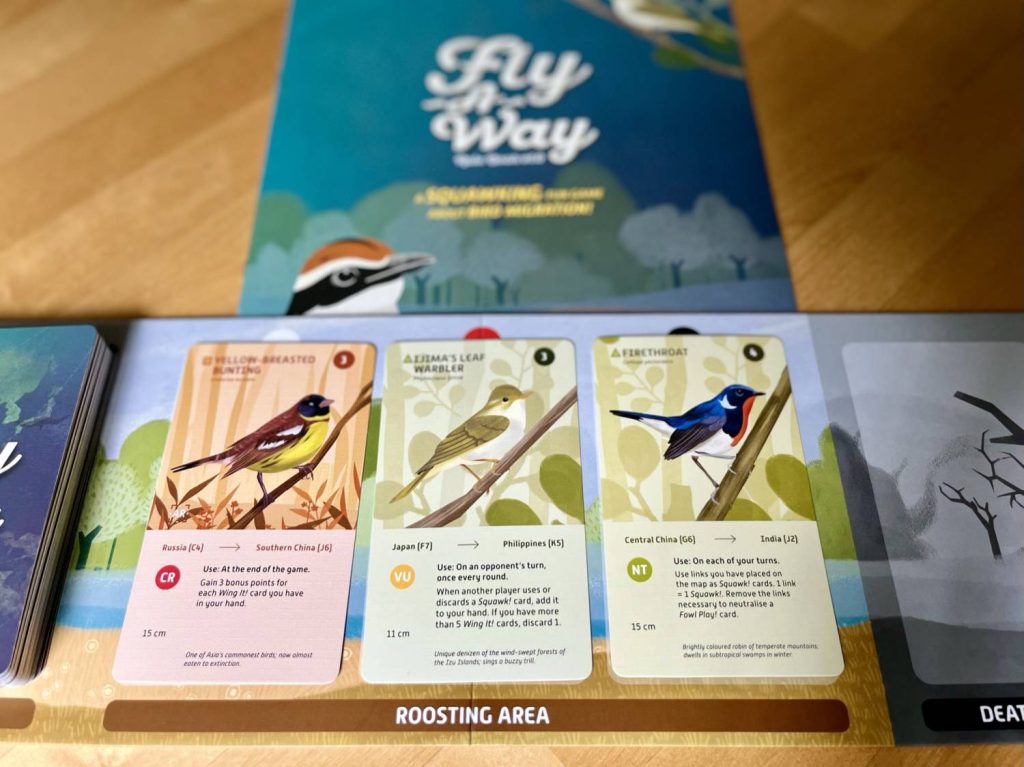
Overview
Before the frosty fingers of November arrive, there is an ever changing assortment of feathers flitting from branch to branch. As the ‘season of mists and mellow fruitfulness’ arrives, it is time to help these birds of passage make their way to warmer climes through the East Asian-Australian Flyway that spans from Russia in the North, through Asia to Australia in the South.
SET UP
The game revolves around informative Bird cards which indicate their habitat, fun facts on the species, their conservation status. Most importantly for the game, the start and end locations of their migratory journey from North to South. These bird cards award points for completed flyway routes. Shuffle these cards and place 3 cards face-up on the roosting area on the Bird Board. Then place the Start and End location markers as indicated on the bird card.
Along their journey, these birds are thwarted by poachers, forest fires, and other natural and man-made threats represented by Fowl Play and Birdtastrophe cards. The two decks are shuffled separately and stacked in alternating fashion depending on the number of players.
Fortunately for our feathered friends, players can rally support by playing Wing It cards and gathering public support to save them. Shuffle all the Wing It cards and deal 2 to each player and place the remaining cards on the Wing It draw slot.
Lastly, each player receives a bird pawn which starts at the 0 mark at the top of the score track and 35 seed-shaped links of the same color.
Game Play
The object of the game is to collect the most points by completing as many migratory routes, to assist and save the birds making their journey. At the start of each turn, players draw one Wing It! card for keeps and one Fowl Play card which must be resolved immediately. Fowl Play cards can be neutralized by completing or neutralizing its effect with Wing It! cards.
There are two types of Wing It! cards. Regular Wing It! cards allow players to place additional links or gain extra points. Squawk cards allow players to offset Fowl Play effects. After Fowl Play or Birdtastrophe card effects have been resolved, place the used cards in their respective discard piles on the Event board.
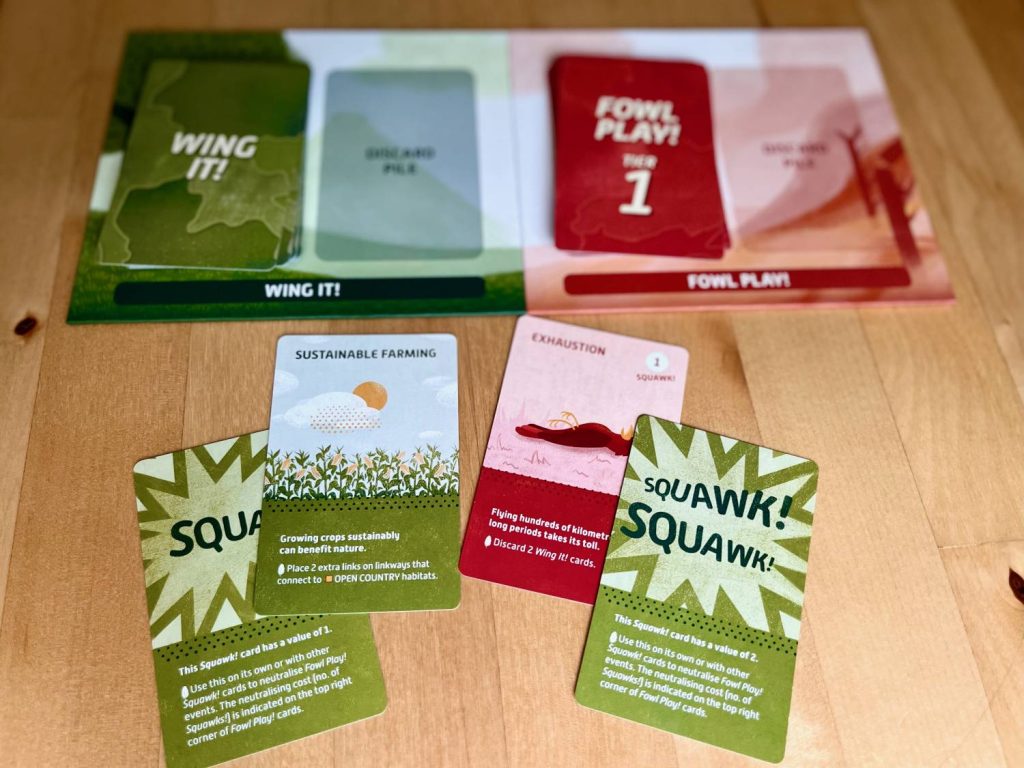
Players can now start or continue building routes by placing links on the map for migratory routes for any of the birds in the Roosting Area. The bird is saved when there is a continuous link from its start and end locations, as indicated on the card. The player who places the last link wins the Bird card and gains the points indicated on its top right corner. All other players who have contributed links to that route also gain points based on the number of links they placed.
When completing these autumnal migration routes, it is important to remember that birds from North to South. Birds do not fly back in the direction they came from, even to find another way down south, so links may not be tracked upward and then turn south.
If any birds have been saved this turn, the board is reset by drawing new cards from the Bird deck to replace cards taken from the Roosting Area. Reassign the location markers for any new cards drawn and keep existing links on the board.

The game ends when a player has saved 6 birds or all Fowl Play cards have been drawn. All players take an equal number of turns in the last round and the points are tallied, including any end game bonus points awarded from Bird cards.
ORNITHOLOGY FOR THE ORDINARY FOLK
After all the excitement generated from recent birding games like Wingspan, it is very exciting to see a board game centered around the Asian continent, especially for a gamer based in Asia.
It was fascinating to see the different types of habitats—wetland, open country and forest—across the map depicted on the jointed routes. I’ve never comprehended the transformation of biomes from one to another, across such extensive landmass. But because they were only coded on the joints, which are fairly diminutive, the breadth of variation is hard to behold and that has a small factor in the gameplay. I would have liked to have seen larger icons or a color-coded map to truly see how it influences the varieties of birds that are attracted to those regions.
Whilst the board is big and beautiful, the real highlight for me are the Bird cards. Despite living in Asia, I am more exposed to North American birds from what I see and read. This was the first time I learnt about these different cool Asian birds! Each card has detailed artwork, the common name, scientific name, as well as a small blurb describing some characteristics.
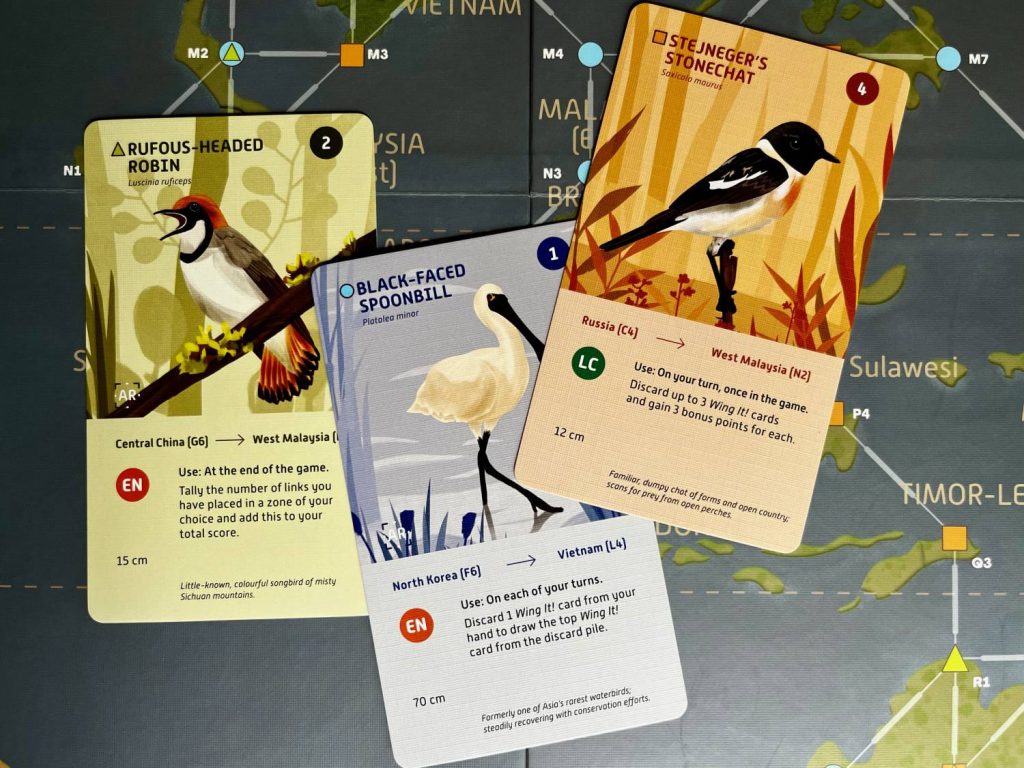
All bird cards also have some additional gameplay ability, either ongoing throughout the game or to be scored at the end. But I cannot say if those abilities have any thematic relation to the actual birds. Winning the Black-faced Spoonbill allows the player to discard Wing It cards in hand to draw Wing It cards from the discard pile. What about this bird suggests that? How about the Ijima’s Leaf Warbler, which can be used on an opponent’s turn to draw their discarded Squawk card? Why this bird and this particular power? Or at the end of the game scoring, why does the Band Bellied Crake allow bonus points for each other Forest bird saved? Who knows? If there is a reason, I’d like to know on the cards!
The game is rife with challenges that threaten to upend the birds’ year-end plans. Fowl Play and Birdtastrophe cards play out as threats to birdlife and the environment, in the form of rising sea levels, forest fires, deforestation, urbanization, overgrazing, and algal bloom. These the players must resolve or be subjected to the cards’ effects.
Some of these effects are nuanced to their threat. For example, the “Wildlife Disease” Fowl Play card causes all birds from the Roosting Area to be discarded and replaced, whereas the “Wild Meat Trade” Fowl Play card causes the player to lose their biggest bird saved, as well as one from the Roosting Area. And, the “Algal Bloom” Birdtastrophe card causes all links connected to Wetland habitats in zones L, M and N to be discarded. But, players can block those effects by playing Wing It! cards that demonstrate conservation efforts—sustainable farming, public support, wetland restoration, government intervention policies and bird migration studies. These problems and solutions are all packaged neatly in the mechanics of the game.
FINAL THOUGHTS
While there is a lot of information on birds and their migratory routes made available throughout the components, the game play does not lend itself much to actually learning about birds. It is completely possible to play the game, take note of the routes, strategize for points, maximize the card benefits and not have learnt anything about the animals, which is a pity for such information laden components. What ends up happening at our game table is players reading the cards, during their downtime on other players’ turns. So, it may take a lot of plays to learn about specific bird types. I have young players, so time is on my side.
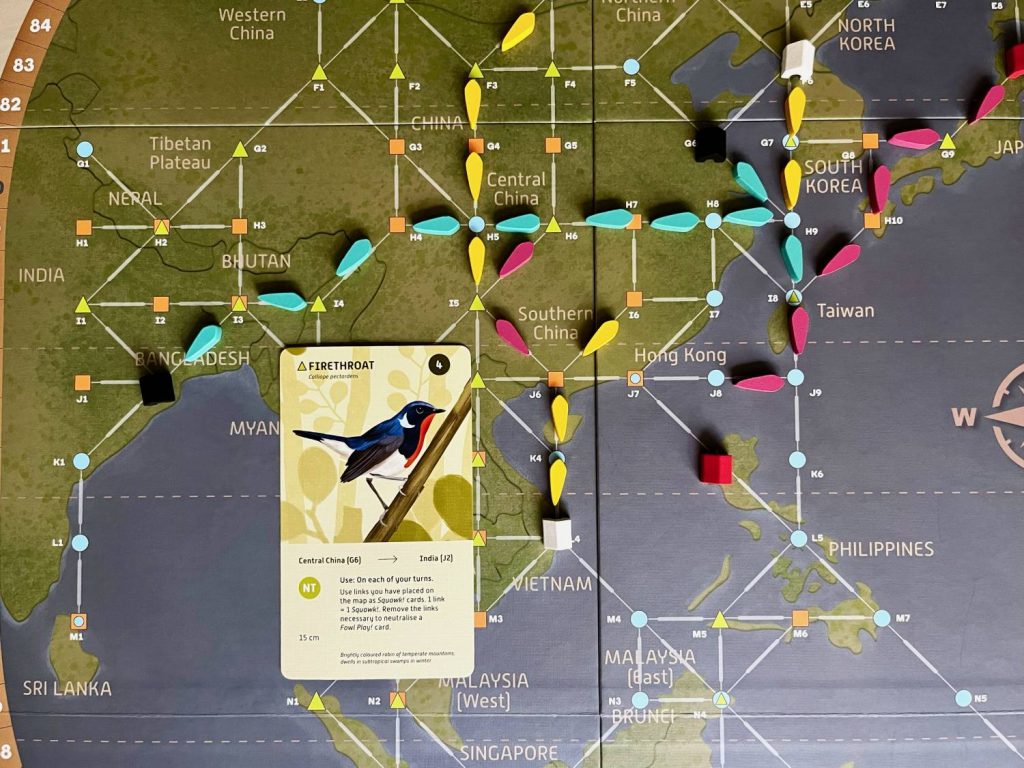
Whilst I really like the board, most of the movement revolves around coordinates rather than place names. Ultimately it is a map-laying game with a ornithology theme, but I could also see this gameplay working also as a train network building game across Asia.
Perhaps the best takeaway as part of gameschooling with Fly-A-Way, is that we have learnt the turns of the different migratory routes and their conclusion. And now we know which birds we might spot depending on where we are based in Asia.
My family will keep playing this game, especially since we have a bird sanctuary in the Singapore Jurong Bird Park. I will take these cards with us on our visits, in hopes that the many mentions of the birds during the game and the visits will spark an interest. Meanwhile, each time we’ve played the game, someone always comments, “Wow, that bird traveled pretty far away!”


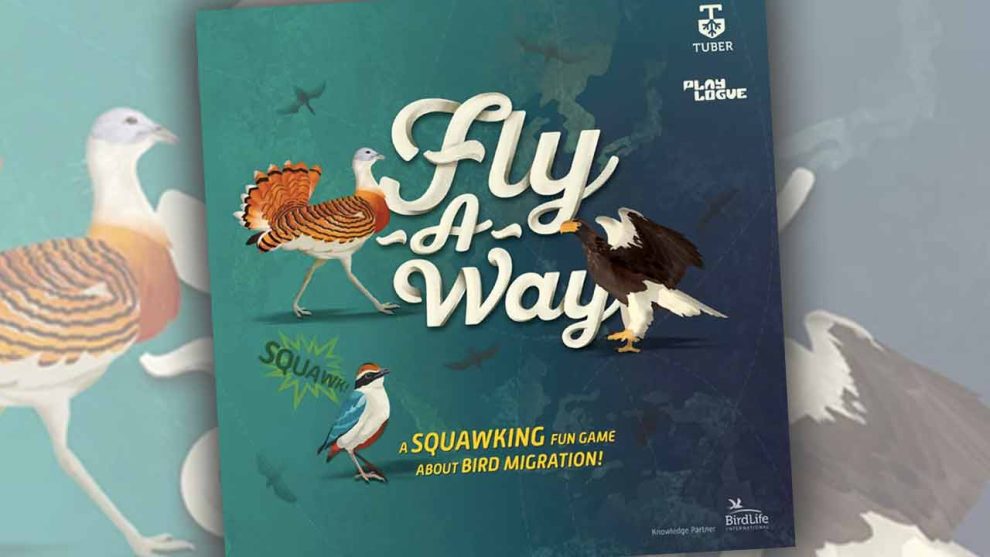
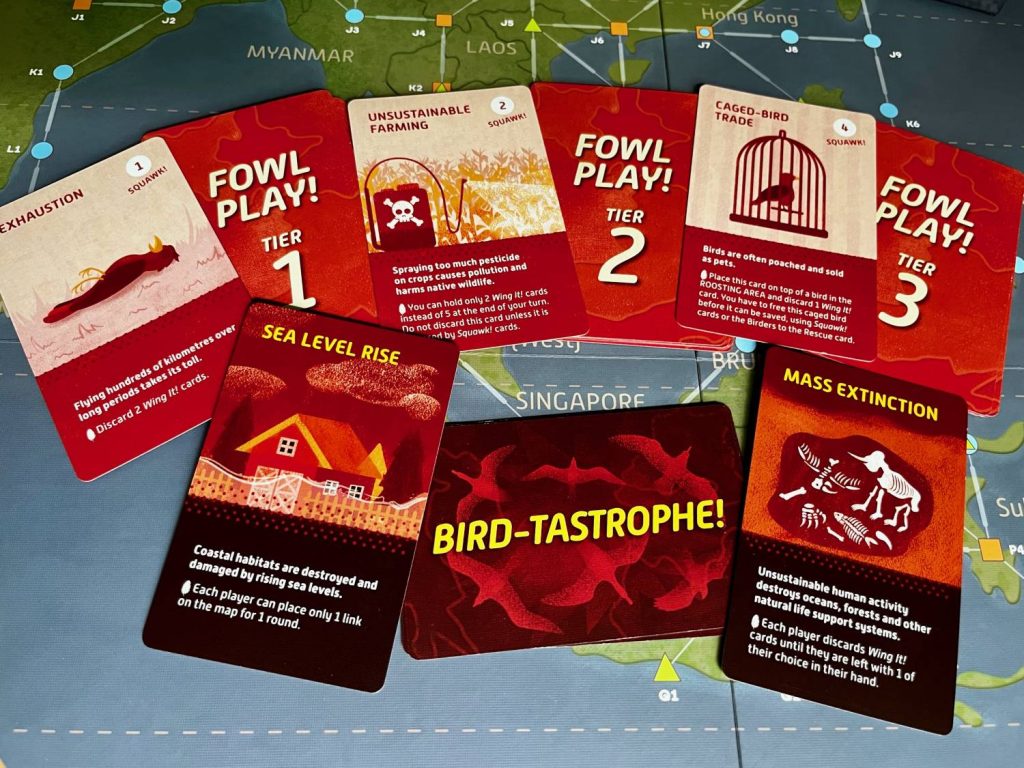
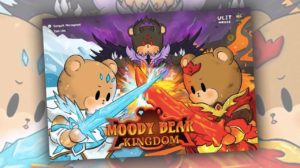

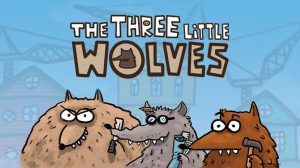





Add Comment